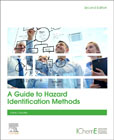
Hazards by their definition are not always obvious. The history of the process industry is littered with incidents where the hazard was not even recognized. There is a need to use the appropriate technique to find them and then determine the best solution for that hazard. A Guide to Hazard Identification Methods, Second Edition, gives a description and examples of the most common techniques leading to a safer and more reliable chemical process industry. This new edition has previous sections revised, brought up-to-date and linked to further sources. Furthermore, new elements include a more detailed account of purpose; Black Swan events; human factors; auditing and QA; more examples and discussion of major incidents; HAZID; Task analysis. Outlines HAZOP - a tried and tested techniqueDiscusses HAZID - a newer technique which has not been adequately described elsewhereIncludes eight new techniques not in first editionIllustrates each tool with practical examplesShows how many techniques are used under the larger umbrella of hazard identification INDICE: 1. Legal Framework Hazard/Safety 2. A Guide to Hazard Identification Methods 3. Hazard Studies 4. HAZOP 5. HAZID 6. Task Analysis 7. Layer of Protection Analysis (LOPA) 8. Relative Ranking 9. The Risk Assessment Screening tool (RAST) 10. Checklists 11. What If? 12. Failure Modes and Effects Analysis (FMEA) 13. Fault Tree Analysis (FTA) 14. Event Trees (Outcome) Analysis 15. Risk Assessment 16. Vulnerability (human and equipment) 17. Safety Audits 18. Bow Tie (may include Black Swans) 19. Process Hazard Review 20. Appendices
- ISBN: 978-0-12-819543-7
- Editorial: Elsevier
- Encuadernacion: Rústica
- Páginas: 212
- Fecha Publicación: 01/05/2020
- Nº Volúmenes: 1
- Idioma: Inglés
